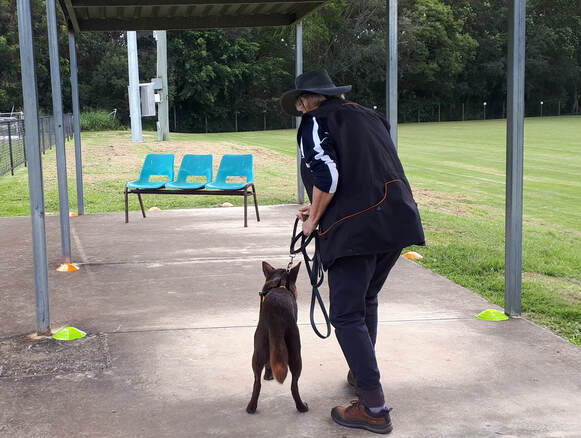START LINE ROUTINE
In a trial, the judge will mark out a threshold 'start line' over which the competitor and dog must pass to begin the search. As a guide, the start line should be no smaller than the width of a doorway, and no larger than three (3) metres across.
It is important that you manage your dog’s emotional state from the car (in the staging area), through the waiting areas along the way to the search area and to the actual start line. Therefore, your trialling routine starts well before the actual start line.
WHAT IS A ROUTINE?
A routine is ‘a sequence of actions regularly followed’. For example, at a Scent Work trial, it includes –
WHY IS A ROUTINE IMPORTANT?
Following a routine that you have practised many times in training can help you in the following ways.
Start line drills should be a regular part of your training. Below are some of our teams practising their rituals.
It is important that you manage your dog’s emotional state from the car (in the staging area), through the waiting areas along the way to the search area and to the actual start line. Therefore, your trialling routine starts well before the actual start line.
WHAT IS A ROUTINE?
A routine is ‘a sequence of actions regularly followed’. For example, at a Scent Work trial, it includes –
- your dog being comfortable waiting in his crate/in the car potentially for several hours, as well as toileting in ‘strange’ locations;
- your dog observing you as you prepare yourself – such as collecting your rewards and placing them in your pocket/treat pouch etc, collecting the lead and collar/harness – and being aware that this is a precursor to …;
- taking your dog out of his crate/car and moving through the various staging posts, where you will need to pause (sometimes sitting down, sometimes standing) until the route ahead is clear;
- putting on the dog’s equipment closer to the search area; and
- finally moving to the search area and engaging in your start line ritual.
WHY IS A ROUTINE IMPORTANT?
Following a routine that you have practised many times in training can help you in the following ways.
- reduce your anxiety and stress associated with a trial;
- keep you from forgetting something important, like treats in your pocket or even your dog’s harness;
- keep you calm and focussed when searching/handling.
Start line drills should be a regular part of your training. Below are some of our teams practising their rituals.
WHAT IS A START LINE RITUAL?
Your actions and words are all cues to the dog as to the job at hand. The first cue is attaching his equipment (maybe changing from a collar to a harness or changing collar, or changing your lead) shortly before reaching the [first] search area. It is also desirable to be consistent in the verbal cues that you use at each stage – when changing his equipment; when entering the search area; when pausing at the start line; and when releasing him to commence searching.
At the start line, we suggest restraining the dog a little by holding his harness or collar, thus building his focus and desire to drive forward on your release/search cue. Whether he sits or stands is up to you, but try to avoid any ‘obedience’ element in your set-up before the start line; we want him to be focussed on the search area, not focussed on you.
As well as both you and your dog taking in the visual picture of the search area at the start line, your dog will be taking in the scents of the area, and may well pick up the target odour at the start line, so pause and take your time at the start line, before releasing your dog/cueing him to search.
Also remember that your dog must enter the search area through the start line. You will incur a fault if, for instance, your dog goes around the start cones rather than through them.
Your actions and words are all cues to the dog as to the job at hand. The first cue is attaching his equipment (maybe changing from a collar to a harness or changing collar, or changing your lead) shortly before reaching the [first] search area. It is also desirable to be consistent in the verbal cues that you use at each stage – when changing his equipment; when entering the search area; when pausing at the start line; and when releasing him to commence searching.
At the start line, we suggest restraining the dog a little by holding his harness or collar, thus building his focus and desire to drive forward on your release/search cue. Whether he sits or stands is up to you, but try to avoid any ‘obedience’ element in your set-up before the start line; we want him to be focussed on the search area, not focussed on you.
As well as both you and your dog taking in the visual picture of the search area at the start line, your dog will be taking in the scents of the area, and may well pick up the target odour at the start line, so pause and take your time at the start line, before releasing your dog/cueing him to search.
Also remember that your dog must enter the search area through the start line. You will incur a fault if, for instance, your dog goes around the start cones rather than through them.

